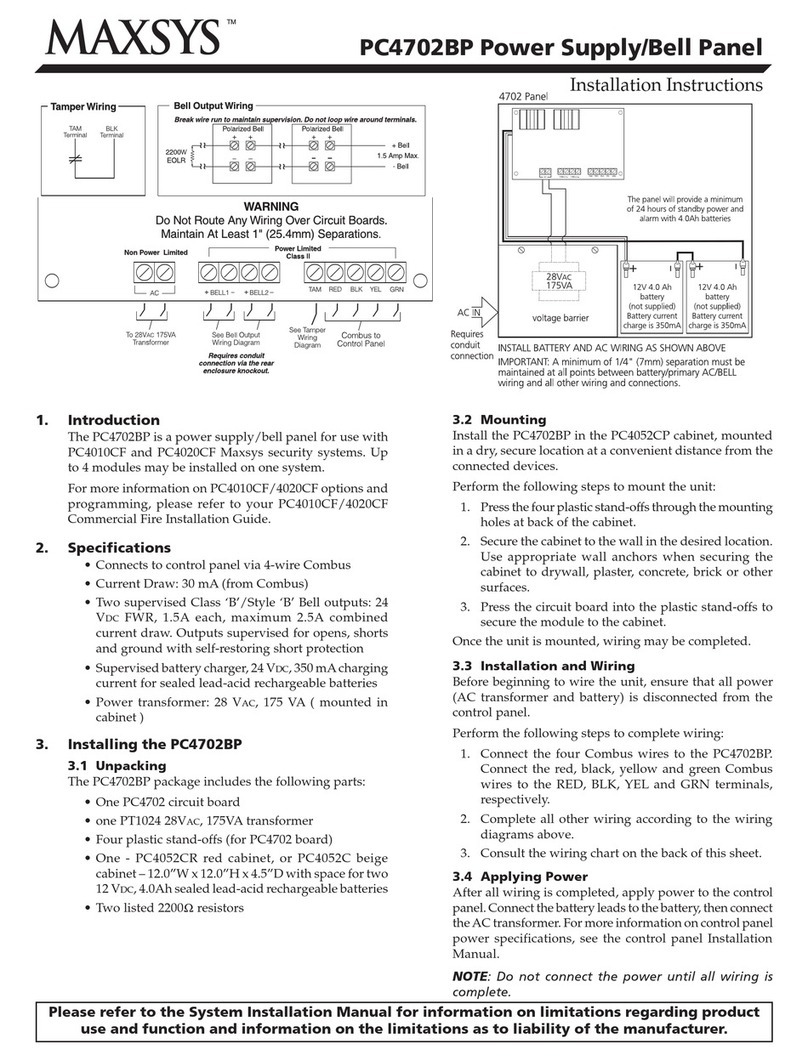
©2017 Tyco Security Products, Toronto, Canada www.dsc.com Tech. Support: 1-800-387-3630
PS4085 Power Supply Module
Installation Manual
This installation sheet shall be used in conjunction with the installation manual of the DSC equipment
to which the PS4085 is connected.
The PS4085 provides up to 1.5A of additional current, up to 4-hour standby time and 15 minutes alarm
time from a rechargeable 12V rated battery.
General
This product meets the requirements of UL603 Standard for Power Supplies used with Burglar-Alarm
Systems and can be used in Mercantile Alarm installations in accordance with the following UL Stand-
ards: UL365, UL609, UL1076, UL1610.
Specifications
lTemperature range: 0°C to +49°C (32°F to +120°F)
lRelative humidity: 93% non condensing
lInput ratings: 120Vac, 60Hz, 300mA
lTransf ormer required: Plug- in adapter model DSC PTC1640UG
lTransformer secondary ratings: 16.5Vac, 40VA
lBoard current draw: 30mA
lBoard dimensions: 145 mm x 83 mm
lOutput rating: 11.5 -12.6VDC, 1.5A (max.)
lResettable fuse (PTC) used on circuit board instead of replaceable fuses
lOutput ripple voltage: 180mVpp
lNo overvoltage protection devices required on the outputs
lStorage device: rechargeable, sealed, lead-acid batteries, rated 12VDC. Replace every 3-5 years
lBattery capacity: 7Ah
lBattery derating factor: minimum 10%
lMaximum standby time: 4h and 15 min alarm
lRecharging time: less than 24 hours
lLow battery trouble indication threshold: 11.2VDC
lBattery deep discharge protection (cut-off at 9.5VDC)
lSupervision for loss or degradation of primary power source (ACT), battery fail or battery low
voltage (LBT) and charger circuitry failure (TEST)
Figure 1 PS4085 Wiring
PS4085
+12V
COM ACT LBT TEST +BAT
AC IN
CON1
TEST - CHARGER TROUBLE OUTPUT 50mA, 25V Max.
LBT - LOW BATTERY OUTPUT 50mA, 25V Max.
ACT - AC FAILURE OUTPUT 50mA, 25V Max.
Recommended Battery:
DSC Model BD7-12
BATTERY CHARGE CURRENT SELECTOR
JUMPER ON A-B = 400mA
JUMPER ON C-B = 700mA
NO JUMPER = FOR FUTURE USE
Primary
120VAC
60Hz, 0.3A
TRANSFORMER
DSC Model PTC1640UG
OUTPUT RATING:
11.5VDC - 12.6VDC, 1.5A
Note: Devices that require power from the PS4085
shall be UL Listed for the intended application and
operation over the range 11.5-12.6VDC
Terminal Descriptions
AC - Supervised input. Connect the secondary of the transformer to these terminals. Connect the
primary of the transformer to a dedicated electrical circuit (commercial fire installations) or to an
unswitched AC source (other applications).
+12V/COM - Special applications output circuit, power limited. Connect to devices that require
power. Connect the positive lead of powered devices to the +12V terminal and the negative lead to the
COM terminal.
ACT - This open collector output activates when an AC Trouble is detected: Rated 50mA.
LBT - This open collector output activates when a Battery Trouble condition is detected: Rated 50mA.
TEST - This open collector output activates when the charging circuit is in a trouble condition: Rated
50mA. These outputs may be used to activate an indicating device, such as an LED, or a relay to
activate devices requiring more current. The terminals may also be connected to a control panel zone
input to generate an alarm and to have the system report trouble conditions.
To report AC failure and low battery conditions with individual reporting codes, connect the ACT and
LBT to individual alarm zones. The ACT and LBT terminals may also be connected to a single alarm
zone. When so connected, both trouble conditions are reported with a single reporting code.
+BAT/-BAT - Used to connect the standby battery, non-power limited. Use single or dual lead battery
wire assembly.
Battery Charge Current
Select the battery charge current using jumper “CON1”. To avoid damage to the battery, do not select
a battery charge rate greater than 0.1 times the battery AHr rating.
Jumper Setting Charge Current Battery Size
A-B 400mA 4Ah
B- C 700mA 7Ah, 14Ah
None Future Use N/A
Note: For UL Listed installations use only 700mA setting.
Applying Power
After all wiring is complete, connect the battery leads to the battery, then connect the AC trans-
former. For information on the power requirements of specific devices, refer to the instructions sup-
plied with the device.
IMPORTANT! Do not connect power until all wiring is complete.
Mounting the Cabinet
When mounting the cabinet, select a dry location within 1m/3.3ft of the control panel.
To mount the cabinet:
1. Press 4 white circuit board stand-offs into the raised mounting holes at the back of the cabinet.
2. Hold the cabinet in position and pull all wiring through the holes in the back.
3. Using the provided mounting screws and appropriate wall anchors, mount the cabinet securely to
the wall.
4. Press the PS4085 module onto the plastic stand-offs.
Enclosures
The PS4085 can be installed in the metal enclosure described below. Tamper protection switches can
be installed on all enclosures, including door opening protection and/or removal from the mounting pos-
ition. Doors can be secured using screws or keylock.
Internal and/or external wiring for this module shall be routed, supported, clamped or secured in a
manner that reduces the likelihood of the following:
• excessive strain on wire and on terminal connections.
• loosening of terminal connections.
• damage of conductor insulation.





















